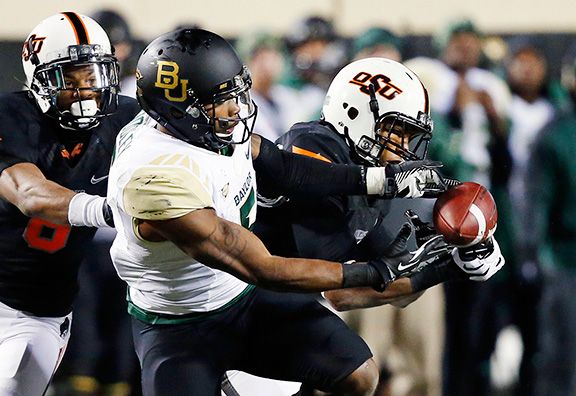
In the first half alone, Baylor has averaged 31.3 points per game during the last two seasons, more than 73 teams average for an entire game.
Two staples of the Bears’ offense have been a fast pace and an ability to gain yards in chunks. Since the start of last season, Baylor has run a play every 19.8 seconds, the second-fastest behind Texas Tech (19.5). However, in the first half, the Bears have been faster, averaging a play every 16.9 seconds, 1.8 seconds faster than any other team.
No team has had more “explosive” plays the last two seasons than Baylor. During that time, the Bears lead the nation in plays per game of 20 yards or more (7.9) and have 11 more touchdowns that covered at least 30 yards than any other FBS school.
Quarterback Bryce Petty has been one of the driving forces behind Baylor’s success. Since becoming the starter before last season, Petty has thrown 37 more touchdowns than interceptions and ranks third in the FBS in yards per attempt (9.9). He has had seven starts with a Total QBR of 90 or more, tied for second-most among FBS quarterbacks behind Marcus Mariota.
…but not the same against top defenses
Since the start of last season, Baylor has played six games against teams that finished last season ranked in the top 40 of ESPN’s defensive efficiency or are currently ranked in the top 40: TCU, Kansas State, Oklahoma State, Texas (twice) and Oklahoma.
Defensive efficiency measures how many points a defense contributes to its team’s scoring margin, adjusting for the strength of opposing offenses faced. All six of those teams held Baylor to fewer than 42 points, whereas Baylor scored at least 42 in each of its 12 other games.
In those six games, Baylor put up numbers more closely aligned with the FBS averages than an offensive juggernaut. The Bears’ 32 points per game is two more than the FBS average and their 437.5 yards per game is 22 more.
Yards after the catch has been a big difference for Baylor against the better defensive teams. The Bears are averaging 106.7 yards after the catch against top-40 defenses compared with 202.0 against all other teams. It comes out to about 2.1 fewer yards after the catch per reception. The average for a Power Five team is 126 yards after the catch per game.
Another difference has been a lack of explosive plays. Four of Baylor’s FBS-high 25 plays of 50 yards or more since the start of last season have come against a top-40 defense. Three of those four plays occurred against Kansas State, which finished the season ranked 38th in defensive efficiency last season.
This week, Baylor faces its first ranked opponent and second top-40 defense of the season in TCU. The Horned Frogs have kept their opponents to an average of 3.8 yards per play this season, third-lowest in the FBS. The last time the Bears were held below four yards per play was by Texas in the 2009 season.


没有评论:
发表评论